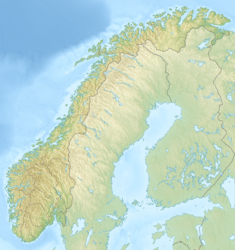| Goliat field | |
|---|---|
 Goliat FPSO in South Korea, 2015 | |
| Country | Norway |
| Location | Barents Sea |
| Block | 229/229B |
| Offshore/onshore | offshore |
| Coordinates | 71°18′N 22°18′E / 71.30°N 22.30°E |
| Operator | Vår Energi AS |
| Partners | Vår Energi (65%) Equinor (35%) |
| Field history | |
| Discovery | 2000 |
| Start of development | 2009 |
| Start of production | 2017 |
| Production | |
| Recoverable oil | 174 million barrels (~2.37×107 t) |
| Producing formations | Kobbe Realgrunnen Snadd Klappmyss |
Goliat field is an offshore oil field in the Norwegian sector of the Barents Sea. It is located 85 kilometres (53 mi) northwest of Hammerfest.[1] The license, awarded in 1997, is owned by Vår Energi AS (operator, 65%) and Equinor ASA (35%). Oil was discovered in 2000.[1][2] The field development concept was approved by the Government of Norway on 8 May 2009.[3] The field will be developed by using Goliat FPSO, a floating production storage and offloading unit.[2]
Goliat field has two main formations (Kobbe and Realgrunnen) and two minor formations (Snadd and Klappmyss).[2] Recoverable reserves are 174 million barrels (27.7×106 m3).[1] The production, which was expected to start in summer 2015 on Goliat oil platform, could only begin in April 2016.[4] Goliat is the northernmost sea oil platform at the moment.[5] Production is estimated to continue for 10–15 years. The associated gas will be reinjected to increase oil recovery or will be transported to the processing plant at Melkøya.[2] Production takes place through a subsea system consisting of 22 wells, of which 12 are oil producers, 7 water injectors and 3 gas injectors.[6] The platforms operation has been halted temporarily in October 2017 due to some of the electrical equipment not being suitable for hazardous areas.[5]
A new reservoir was uncovered in 2018 in the southern Hammerfest Basin.[7]
- ^ a b c "Status updates for offshore field development projects: Goliat". SubseaIQ. Bishop Interactive. Archived from the original on 2011-02-09. Retrieved 2010-08-27.
- ^ a b c d "Goliat, Norway". Offshore-Technology. Net Resources International. Retrieved 2010-08-27.
- ^ Friend, Phaedra (2009-05-08). "Eni Approved for Goliat Development, First Oil Field in Barents Sea". Rigzone. Bishop Interactive. Retrieved 2010-08-27.
- ^ "Eni starts production of Goliat Norwegian field | Eni". www.eni.com.
- ^ a b "Stenger «Goliat»: - Vi kan ikke ha gnister i eksplosjonsfarlige områder" (in Norwegian). 2017-10-06. Retrieved 2017-10-10.
- ^ "Eni starts production of Goliat Norwegian field | Eni". www.eni.com.
- ^ "More Resources Uncovered in Goliat Field". Offshore Engineer. 3 January 2019. Retrieved 12 May 2021.
